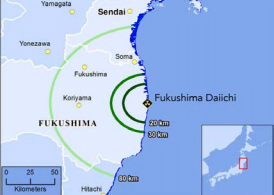The latest update from the UN Office for the Coordination of Humanitarian Affairs:
Casualties: 27,600 dead or missing
As of the 30 March, the official death toll from the 11 March earthquake and tsunami that devastated the northeast coast of Japan now stands at 11,257. Another 16,344 people remain missing.
Displacement
There are now 173,200 people living in more than 2,000 evacuation centres in 17 prefectures mostly in the north of Japan. In the three worst affected prefectures, Miyagi, Iwate and Fukushima, 146,628 evacuees are living in some 1,245 evacuation centres.
Transportation Infrastructure:
The Ministry of Land, Infrastructure and Transport reports that more than 90 per cent of the Tohoku region’s main land, sea and air routes are open. More than 37,200 vehicles are now passing through the Tohoku Expressway per day, which is 1.3 times more traffic than before the disaster struck. All 15 ports and most airports are now open. Railway lines are still under repair. Express buses are carrying 4,400 people per day into and out of the region which is more than twice as many passengers than before the disaster. However, roads in the affected cities and towns are still damaged or blocked with debris and this is hampering the delivery of aid to the many smaller evacuation centres. Relief items are being delivered on foot in some places.
Electricity:
An estimated 190,000 households (492,000 people) remain without electricity. Another 330,000 households (936,000 people) are without gas supplies. Water availability has improved by about 25 per cent in the last few days. Currently, 372,000 households (913,000 people) are still without water in nine prefecture.
Nuclear Crisis:
Radioactive water found in and outside reactor buildings is delaying work to restore cooling functions of the Fukushima Daiichi nuclear power plant. Seawater near the Fukushima Daiichi nuclear plant has reached a much higher level of radiation than previously reported. New readings from a sample of sea water found radioactive iodine at 3,355 times the legal limit. Japan’s Nuclear Safety Agency says this does not pose a health risk. The Government says it is expected to take a considerable amount of time before the temperatures of fuel rods in the reactor cores at the power station are lowered to a stable state. The International Atomic Energy Agency says the situation at the Fukushima Daiichi plant remains very serious. A Joint FAO/IAEA Food Safety Assessment Team met with local government authorities in Ibaraki Prefecture on Monday who briefed the team on the extent of contamination in Ibaraki, the principle agricultural products affected, the main production areas and production methods and levels of contamination found. The FAO/IAEA team also meet with the local authorities in Tochigi Prefecture yesterday, and will meet with local government officials in Gunma today.
U.S. Military Response:
Since Operation Tomodachi started US Military forces have delivered more than 185 tons of food, 3,638,184 gallons of water and 17,836 gallons of fuel, in support of Japan Self Defense Force efforts. Currently, 19 ships, 133 aircraft and 18,165 personnel of the 7th Fleet are operating in support of the Operation to assist Japan. Since Operation Tomodachi started, U.S. 7th Fleet forces have delivered more than 240 tons of humanitarian assistance supplies to tsunami and earthquake areas.
